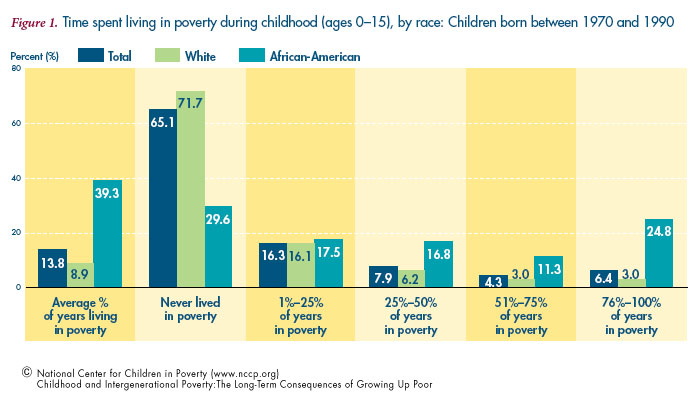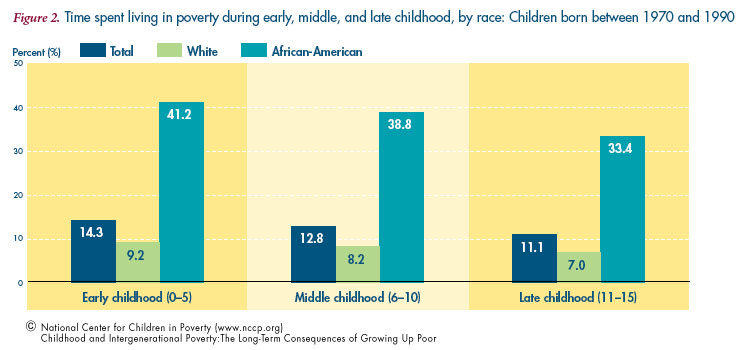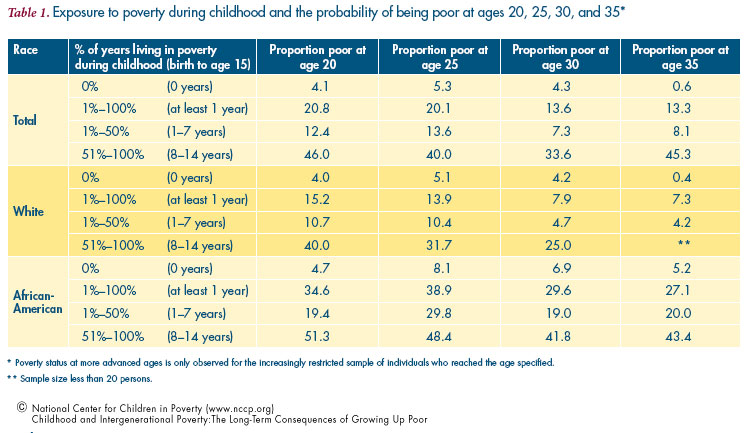Introduction
Children growing up in low-income families face many challenges that children from more advantaged families do not. These children are more likely to experience multiple family transitions, move frequently, and change schools. The schools they attend are less well funded, and the neighborhoods they live in are more disadvantaged. The parents of these children have fewer resources to invest in them and, as a consequence, their homes have fewer cognitively-stimulating materials, and their parents invest less in their education. The stress of living in poverty and struggling to meet daily needs can also impair parenting.
Social and economic deprivation during childhood and adolescence can have a lasting effect on individuals, making it difficult for children who grow up in low-income families to escape poverty when they become adults. Because the negative effects of deprivation on human development tend to cumulate, individuals with greater exposure to poverty during childhood are likely to have more difficulty escaping poverty as adults. In this research brief, we examine patterns of exposure to poverty during childhood and the association between these patterns and poverty in early and middle adulthood. Data for this study come from the Panel Study of Income Dynamics (PSID), which collects information on the social and economic status of PSID families and their offspring every year.
We find that individuals who grow up in poor families are much more likely to be poor in early adulthood. Moreover, the chances of being poor in early adulthood increase sharply as the time spent living in poverty during childhood increases. At all levels of poverty during childhood, African-Americans are more likely than whites to be poor in early and middle adulthood.
Background
“The American Dream” is rooted in the idea of upward mobility, the idea that individuals and families can escape the confines of poverty and disadvantage through hard work and perseverance. How widespread is upward mobility across generations? How do parents’ socioeconomic characteristics influence their children’s success? Do children from more affluent families remain at the top of the economic structure? Are poor children able to escape poverty as adults? How does race impact income mobility, especially mobility out of poverty? Intergenerational economic mobility is a key indicator of the degree of equality of opportunity in a society. Even though the limited availability of long-term, longitudinal data makes economic mobility research challenging, social scientists have been studying intergenerational mobility for some time.
A number of researchers have investigated intergenerational economic mobility by examining the correlation between parents’ and children’s income and earnings. For example, Becker and Tomes report a weak correlation (0.2) between parents’ and children’s incomes. By the 1990s, other researchers’ estimates of the intergenerational income correlation were stronger (closer to 0.4). Mazumder, however, contends that traditional approaches to measuring the correlation between parents’ and children’s income and earnings tend to systematically underestimate this relationship, leading researchers to conclude that there is greater economic mobility in the United States than actually takes place. Using Survey of Income and Program Participation (SIPP) earnings data, Mazumder estimates a stronger correlation between parents’ and children’s earnings to be 0.6. Thus, the literature suggests that the actual correlation between parents’ and children’s income ranges from 0.4 to 0.6, suggesting that intergenerational economic mobility in the U.S. is lower than previous studies found. Mayer and Lopoo caution that all estimates of an intergenerational income or earning correlation can vary depending on the time frame used by the researchers.
Recently, Isaacs’ analysis of income mobility using data from the PSID differentiates between the absolute and relative economic mobility of children. For example, she reports that two-thirds of adult Americans earn more than their parents did 30 years earlier. Thus, in absolute terms, most adult children eventually have greater incomes than their parents. Isaacs, however, also finds that relative income mobility among children is limited. That is, children who were born to families at the top of the income structure have the highest probability of being in the highest income strata as adults, while those born at the bottom have the highest probability of being poor as adults. Isaacs suggests that “about half of the difference in income between families in one generation persists into the next generation.”
Studies focusing on the intergenerational transmission of poverty find that while individuals can break out of intergenerational cycles of poverty, they are less likely to do so than is commonly thought. Moreover, when subsequent generations do escape poverty they are likely to move into the ranks of the slightly less poor. Poverty exits depend on numerous factors such as educational and employment opportunities, the availability of role models, and child and parent aspirations, as well as a child’s birth order and when in the child’s life poverty occurs.
Researchers also find that the intergenerational correlation between incomes and earnings vary widely by race. For example, according to Hertz, 17 percent of whites who were born in the lowest income category between 1942 and 1972 remained there as adults while 42 percent of African-Americans did so. Similarly, in a separate study, Isaacs finds that not only do African-American children live in families with lower average incomes than whites, but “African-Americans experience less upward mobility and more downward mobility than whites.” In general, scholars have found that race matters a great deal in intergenerational economic mobility.
Although researchers have examined how having poor parents influences the chances of being poor as an adult and how the timing of poverty in childhood influences economic success in adulthood, little attention has been given to understanding how the duration of exposure to poverty during childhood influences the chances of being poor in early and middle adulthood. In this study, we use data from the PSID to examine individuals’ patterns of exposure to poverty during childhood and how these patterns are associated with poverty status at the ages of 20, 25, 30, and 35. Because earlier studies have found stark racial differences in patterns of exposure to poverty and intergenerational poverty, we examine these patterns and associations separately for whites and African-Americans.
Data and Methods
We use data from the Panel Study of Income Dynamics to study intergenerational poverty. The PSID is a publicly-available, nationally representative panel study conducted annually or bi-annually since 1968 by the Survey Research Center at the University of Michigan. In the PSID, individuals from original sample households are re-interviewed every year, whether or not they are living in the same dwelling or with the same people. Adults are followed as they grow older, and children are observed as they advance through childhood and into adulthood, forming family units of their own. This procedure produces an unbiased sample of families each year as well as a continuously representative sample of children born into families each year. As of 2005, the PSID data included longitudinal information on 67,271 individuals who were either members of one of the original sample families, the offspring of one of those individuals, or their co-residents.
Our sample includes all white and African-American children born into responding sample families between 1970 and 1990. Because the PSID sampled the original families in 1968, the data include too few Latinos to compute reliable and representative estimates for this population. The youngest individuals in our sample were born in 1990 and were age 15 at the time of the 2005 interview. The oldest individuals were 35 at the time of the last interview. Individuals with poverty information available for fewer than half of the study years were excluded from the analysis. Sample attrition has been modest and has not generally affected the representativeness of the sample. Nonetheless, sampling weights that accounted for attrition were employed in all analyses.
Recently, Grieger, Danziger, and Schoeni developed a strategy for constructing poverty measures using the PSID that are comparable to official Census Bureau estimates using the Current Population Survey. We use this new strategy (called PSID-4 by the authors) to construct poverty indicators for each individual for each year of their childhood (ages birth to 15 years old) and for the ages of 20, 25, 30, and 35 years old. We then use these poverty indicators to compute the percentage of childhood years spent living in poverty (<100 percent Federal Poverty Line). All results presented below are weighted using the PSID individual-level core sample weights.
Poverty During Childhood

Exposure to poverty during childhood varies widely (see Figure 1). Most children (65 percent) never experience poverty between the ages of birth and 15 years old. Of those who are poor at some point during their childhood and early adolescence, most (69 percent) are poor for less than half of that time. However, one in 10 children spend at least half of childhood living in poverty and 6.4 percent are poor for three-quarters or more of childhood. On average, a child spends nearly 14 percent of his or her childhood living in poverty. Children who were ever poor during childhood spend an average of 47 percent of childhood living in poverty.

African-American children and younger children are more likely to experience poverty than white children and older children. While nearly three-quarters of white children never experience poverty during their childhood, fewer than one-third of African-American children are never poor (see Figure 1). Nearly one-quarter of African-American children live in poverty for more than three-fourths of their childhood and more than one-third are poor for at least half of their childhood. On average, a white child spends only 8.9 percent of childhood living in poverty. By contrast, an African-American child is poor for nearly two-fifths of childhood on average. For both white and African-American children, the chances of being poor declines slowly but steadily between early and late childhood (see Figure 2).
Intergenerational Poverty: The Consequences of Growing Up Poor
Adults who were poor during childhood are much more likely to be poor in early and middle adulthood than are those who were never poor (see Table 1). Few adults who did not experience poverty during childhood are poor in early and middle adulthood. At ages 20, 25, and 30, only four to five percent of those adults who were never poor during their childhood live in poverty. At age 35, less than one percent are poor.
Poverty rates for adults who were poor during childhood are much higher, especially for those individuals with high levels of exposure to poverty during childhood. For adults who experienced low-to-moderate levels of poverty during childhood (one to 50 percent of childhood years), 12 to 13 percent are poor at ages 20 and 25 and seven to eight percent are poor at ages 30 and 35. For adults who experienced moderate-to-high levels of poverty during childhood (51 to 100 percent of childhood years), between 35 percent and 46 percent are poor throughout early and middle adulthood.

At comparable levels of exposure to poverty during childhood, African-Americans are more likely than whites to be poor throughout early and middle adulthood. For example, while 0.5 to five percent of whites who were never poor during childhood are poor in their 20s and early 30s, five to eight percent of African-Americans with no exposure to poverty during childhood are poor. At higher levels of poverty exposure during childhood, the differences between African-American and white poverty rates in adulthood are starker. At low-to-moderate levels of poverty exposure during childhood, four to 11 percent of whites are poor in early and middle adulthood, but 19 to 30 percent of African-Americans are poor. At moderate-to-high levels of childhood poverty exposure, 42 to 51 percent of African-Americans are poor as adults, but only 25 to 40 percent of whites are poor. African-Americans are, therefore, doubly disadvantaged relative to whites. On one hand, they have greater exposure to poverty during childhood than whites. On the other hand, at similar levels of exposure to poverty during childhood, they are more likely to be poor as adults. It also appears that low-to-moderate levels of poverty have a particularly disproportionate impact on African-Americans’ mobility as compared to whites.
Conclusion
Our examination of PSID data indicates that while most children never experience poverty, 35 percent of children born between 1970 and 1990 experienced poverty between birth and age 15. We also find that African-American children are more likely to experience poverty than are white children. These results have implications for adults: Individuals who were poor during childhood are more likely to be poor as adults than are those who were never poor, and this is especially true for African-Americans. Consequently, intergenerational poverty and persistent disadvantage impedes individuals’ ability to achieve the American Dream. Though there is considerable upward mobility in the United States, escaping poverty is difficult, and racial disadvantages mean that mobility out of poverty for African-Americans is far more difficult than it is for whites.
Endnotes
1. Duncan, Greg J.; Brooks-Gunn, Jeanne. 1997. Consequences of Growing Up Poor. New York: Russell Sage Foundation.
2. Teachman, Jay D. 2008. The Living Arrangements of Children and Their Educational Well-being. Journal of Family Issues 29(6): 734-761.
3. Brooks-Gunn, Jeanne; Duncan, Greg J.; Aber, J. Lawrence. 2000. Neighborhood Poverty: Policy Implications in Studying Neighborhoods. New York: Russell Sage Foundation.
4. Haveman, Robert; Wolfe, Barbara. 1994. Succeeding Generations: On the Effects of Investments in Children. New York: Russell Sage Foundation.
5. Yeung, W. J.; Linver, M. R.; Brooks-Gunn. J. 2002. How money matters for young children’s development: Parental Investment and Family Processes. Child Development.
6. Corcoran, Mary. 1995. Rags to Rags: Poverty and Mobility in the United States. Annual Review of Sociology 21: 237-267. Ashenfelter, Orley; Card, David (eds.) 1999. Intergenerational Mobility in the Labor Market, Amsterdam: North-Holland. Handbook of Labor Economics 3A: 1761-1800.
7. Beginning in 1997, the PSID reinterviewed families biennially.
8. Isaacs, Julia B.; Sawhill, Isabel V.; Haskins, Ron. 2008. Getting Ahead or Losing Ground: Economic Mobility in America. Washington, DC: Brookings Institution.
9. Hertz, Tom. 2007. Trends in the Intergenerational Elasticity of Family Income in the United States. Industrial Relations 46: 22-50.
10. Becker, Gary S.; Tomes, Nigel. 1986. Human Capital and the Rise and Fall of Families. Journal of Labor Economics 4: S1-S39.
11. Solon, Gary. 1992. Intergenerational Income Mobility in the United States. American Economic Review 82:393-408.
Zimmerman, David J. 1992. Regression Toward Mediocrity in Economic Stature. American Economic Review 82: 409-429.
For fuller discussions of this research see Corcoran in endnote 6 and Mazumder, Bhashkar. 2005a. Fortunate Sons: New Estimates of Intergenerational Mobility in the United States Using Social Security Earnings Data. The Review of Economics and Statistics 87: 235-255.
14. See also: Hertz, Tom. 2005. Rags, Riches, and Race: The Intergenerational Economic Mobility of Black and White Families in the United States. pp. 165-191, in Unequal Chances: Family Background and Economic Success, Bowles, Samuel; Gintis, Herbert; Osborne, Groves, Melissa; eds. New York: Russell Sage Foundation.
Mazumder, Bhashkar. 2005b. The Apple Falls Even Closer to the Tree than We Thought: New and Revised Estimates of the Intergenerational Inheritance of Earnings. pp. 80-99, in Unequal Chances: Family Background and Economic Success, Bowles, Samuel; Gintis, Herbert; Groves, Melissa Osborne, eds. New York: Russell Sage Foundation.
15. Mayer, Susan E.; Lopoo, Leonard M. 2005. Has the Intergenerational Transmission of Economic Status Changed? The Journal of Human Resources 40: 169-185.
17. Harper, Caroline; Marcus, Rachel; Moore, Karen. 2003. Enduring Poverty and the Conditions of Childhood: Life Course and Intergenerational Poverty Transitions. World Development 31(3): 535-554.
18. Rodgers, Joan R. 1995. An Empirical Study of Intergenerational Transmission of Poverty in the United States. Social Science Quarterly 76(1): 178-194.
Yaqub, S. 2000. Intertemporal Welfare Dynamics: Extents and Causes. Conference paper presented at Globalization: New Opportunities, New Vulnerabilities. Brookings Institution/Carnegie Endowment Workshop. [http://www.ceip.org/files/pdf/shahin_dynamics.pdf].
19. Glewwe, P.; H. Jacoby; King, E. 1999. Early Childhood Nutrition and Academic Achievement: A Longitudinal Analysis. Discussion Paper No. 68. Washington, DC: IFPRI/FCND.
Wagmiller, Robert; Lennon, Mary Clare; Kuang, Li; Alberti, Philip; Aber, J. Lawrence. 2006. Dynamics of Family Economic Disadvantage and Children’s Life Chances. American Sociological Review 71(5): 847-866.
25. See endnote 13; endnote 19: Wagmiller et al.
26. Duncan, Greg J.; Hill, Daniel H. 1989. Assessing the quality of household panel survey data: The case of the PSID. Journal of Business and Economic Statistics7(4): 441-51; Hill, Martha. 1992. The Panel Study of Income Dynamics – A User’s Guide. Thousand Oaks, CA: Sage Publications.
27. Grieger, Lloyd D.; Danziger, Sheldon; Schoeni, Robert F. 2007. Estimating and Benchmarking the Trend in the Poverty Rate from the Panel Study of Income Dynamics. Ann Arbor, MI: PSID Technical Series Paper #07-03. [http://psidonline.isr.umich.edu/Publications/Papers/tsp/2007-03_Estimating_and_Benchmarking_the_Trends.pdf].
28. We examine the time spent living in poverty between the age 0 and 15 years for several reasons. First, some children leave their parent’s families between the ages of 16 and 18 years making it difficult to classify these children’s family poverty status in the latter stages of childhood. Second, this interval allows us to construct equal width 5-year intervals. Third, other researchers studying the timing of poverty during childhood have used these intervals.
Duncan, Greg J., Yeung, W. Jean, Brooks-Gunn, Jeanne and Smith, Judith R.. 1998. How Much Does Childhood Poverty Affect the Life Chances of Children? American Sociological Review 63: 406-23.
29. We also conducted the analysis based on different birth cohorts and there are some variations across age cohort. However, it was not possible to examine intergenerational poverty for all birth cohorts because later cohorts are not old enough to be observed as adults.
